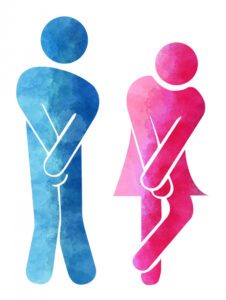Pelvic floor physio to help pain during sex (treatment for dyspareunia/vaginismus)
Written by Nathalie and YuXin,
Some women can report pain or burning sensations during vaginal penetration during sex; while entry of 1-2 fingers; or putting a tampon in the vagina. Most of the time, doctors recommend using a lubricant. But when a lubricant doesn’t help, it could be interesting to investigate further. It might be dyspareunia.
Why is there pain?
- Decreased relaxation: The pelvic floor muscle that surrounds the vagina that should relax to let in the penis or fingers penetrate fails to relax.
- Hypertonicity or decreased length (flexibility): The pelvic floor muscle or skin might be too tight. During sex, a stretch of the tight muscle is like when we want to stretch a very tight thigh to be able to do a split. Stretching too much of a tight structure can cause pain.
- Sensitivity at the vestibule (vestibulodynia): The vestibule is located at the vaginal entry. It is highly rich in nerve endings that might overreact to a touch stimulus, amplify the signal and interpret it as painful or burning.
- Soft tissue changes (of trophicity): The vaginal mucosa might be dehydrated and lose their ability to stretch to allow friction of a penis or finger towards it.
Difference between dyspareunia and vaginismus
Dyspareunia is a general term describing pain during sex. Vaginismus is a type of dyspareunia that involves additional psychological factors to the pain. For example, fear of having someone else touch one’s body might cause important fear and stress. The pelvic floor muscles might be out of control and contract instead of relax during a sexual relationship.
Role of pelvic floor physio
A pelvic floor physio has specific training in assessing pelvic floor conditions.
Here is what happens during an initial evaluation:
- An interview on the history of your symptoms and general questions on the urinary, sexual, fecal, and organ support functions.
- Evaluation of the breathing technique.
- External observation and palpation of the pelvic floor muscle contraction, relaxation, tone.
- Intra-vaginal palpation with 1 or 2 fingers to assess pelvic floor muscle contraction, relaxation, tone.
- Some patients (mainly with vaginismus) might not feel comfortable to allow a therapist to perform an observation or palpation at the first session. In such cases, the therapist could guide the patient through a self-evaluation.
Physio treatment:
In the first session, your pelvic floor physio will recommend a treatment plan and give the first few exercises or manual treatments depending on the findings on the assessment. The treatments may include
- Breathing techniques or general relaxations to help relax the pelvic floor muscle
- Exercises and manual guidance to improve control of pelvic floor muscle (especially do a full relaxation)
- Manual release, stretches, exercises, or dilator therapy to decrease the pelvic floor muscle tension and increase pelvic floor muscle flexibility
- Desensitization exercises of the vestibule
- Recommendations on improving the hydration and mobility of the perineum skin.
If this condition is affecting your life and you are interested to learn more about pelvic floor exercises and treatments, do not hesitate to contact with us! Our well-trained physiotherapists are here to help you!
References:https://www.babycenter.ca/a196/postpartum-exercise—is-your-body-ready



Recent Comments